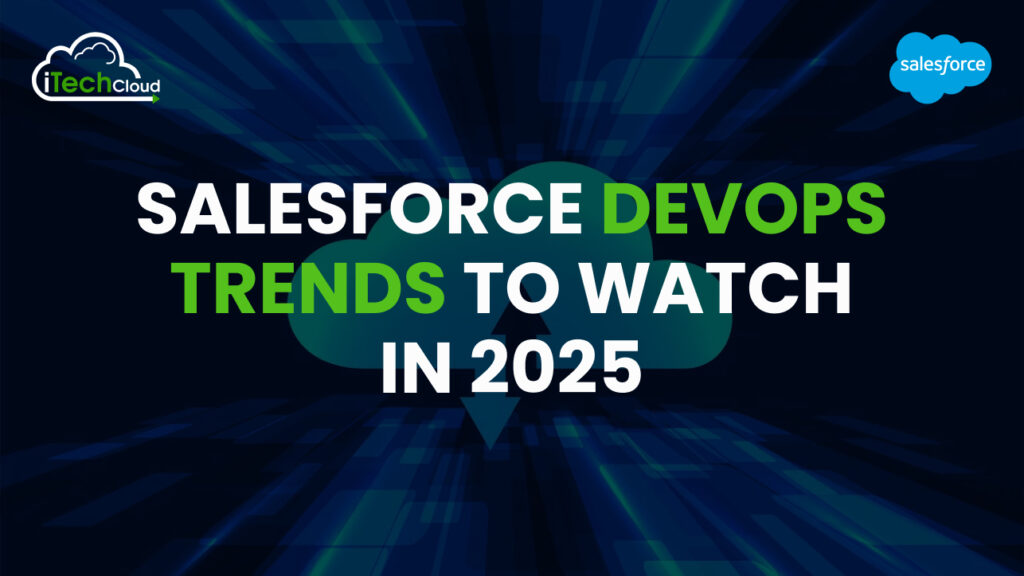Salesforce DevOps Trends to Watch in 2025

Salesforce DevOps is undergoing significant transformations, driven by technological advancements and evolving business needs. Staying abreast of these trends is crucial for organizations aiming to maintain a competitive edge.
Table of Contents
Here’s an in-depth look at the key Salesforce DevOps trends to watch in 2025.
1. AI-Powered DevOps (AIOps)
Artificial Intelligence (AI) is increasingly becoming integral to DevOps workflows. In 2025, AI-driven tools are expected to streamline processes such as code reviews, testing, and deployment. By automating repetitive tasks, these tools reduce human error, ensuring more reliable and efficient pipelines. Machine learning algorithms can predict potential bottlenecks in the development process, allowing teams to address issues proactively, resulting in smoother releases.
2. DevSecOps Becomes Standard
Security is no longer an afterthought in the DevOps lifecycle. The integration of security practices into every phase of development, known as DevSecOps, is becoming standard. This approach ensures that security is embedded throughout the development process, reducing risks and vulnerabilities. Automated security checks, AI-driven vulnerability scanning, and real-time security monitoring are key components of this trend.
3. Unified Deployment Processes
Deployment practices varied between developers and administrators, creating silos and inefficiencies. In 2025, there is a growing adoption of unified deployment processes across Salesforce teams. Standardizing pipelines ensures that changes whether declarative or programmatic are handled through a single, cohesive process, improving collaboration and efficiency. Organizations with unified pipelines report faster deployments and a significant reduction in deployment-related issues.
4. Rise of GitOps and Infrastructure as Code (IaC)
The combination of GitOps and Infrastructure as Code is revolutionizing infrastructure management. GitOps involves using Git repositories as the source of truth for infrastructure configurations, enabling traceability and automation. Deployment and updates are automated using tools like Terraform, ArgoCD, and Flux, ensuring consistency across development, staging, and production environments. These practices are becoming a baseline for managing complex, scalable infrastructure.
5. Observability and Monitoring
Advanced monitoring and analytics are critical components of Salesforce DevOps in 2025. Teams are investing in tools that provide real-time insights into their environments, enabling proactive management of systems. These solutions help monitor key performance indicators, identify irregularities early, and address potential problems before they affect end users. AI-powered analytics offer deep insights into application performance and user experience, facilitating proactive issue resolution.
6. Focus on Release Quality
While speed has always been a priority in DevOps, there is a shift towards emphasizing release quality in 2025. Teams are realizing that faster deployments are meaningless without stability and reliability. As a result, organizations are prioritizing robust testing processes and sandbox seeding to ensure that every release meets high-quality standards. Improved release quality not only reduces the risk of post-deployment failures but also enhances user satisfaction.
7. Democratization of DevOps
The gap between admins and developers is narrowing as declarative DevOps becomes more accessible. Platforms are now supporting low-code and no-code contributors, enabling them to participate in the DevOps pipeline. This democratization fosters collaboration and allows teams to deploy all changes regardless of their source using the same tools and processes. By unifying workflows, organizations are unlocking higher efficiency and better performance.
8. Adoption of Salesforce-Specific Backup Solutions
Data security and compliance remain top priorities for Salesforce teams. In 2025, there’s a growing emphasis on adopting specialized backup solutions tailored for Salesforce environments. These tools ensure that data and metadata are backed up frequently and can be recovered quickly in case of issues, safeguarding against data loss and ensuring business continuity.
9. Integration of Cloud-Native DevOps
The symbiotic relationship between cloud-native architectures and DevOps practices continues to grow. In 2025, Salesforce teams are leveraging cloud-native tools to streamline deployments, enhance scalability, and optimize resource usage. Cloud-native DevOps enables teams to manage distributed systems efficiently, ensuring high availability and performance. This integration is driving innovation and setting new benchmarks for what’s possible in Salesforce DevOps.
10. Sustainability in DevOps
Sustainability is gaining traction in Salesforce DevOps as organizations aim to reduce their environmental footprint. Teams are optimizing resource usage, designing energy-efficient workflows, and adopting green practices throughout the DevOps lifecycle. This trend reflects a broader shift in the tech industry towards environmental responsibility, with DevOps playing a crucial role in achieving these goals.
Conclusion
The Salesforce DevOps in 2025 is characterized by increased automation, enhanced security, unified deployment processes, and a focus on quality and sustainability. By embracing these trends, organizations can improve efficiency, reduce risks, and stay competitive in an increasingly digital world. Teams that adapt to these changes will be well-positioned to deliver high-quality software at scale while meeting the demands of modern businesses.

